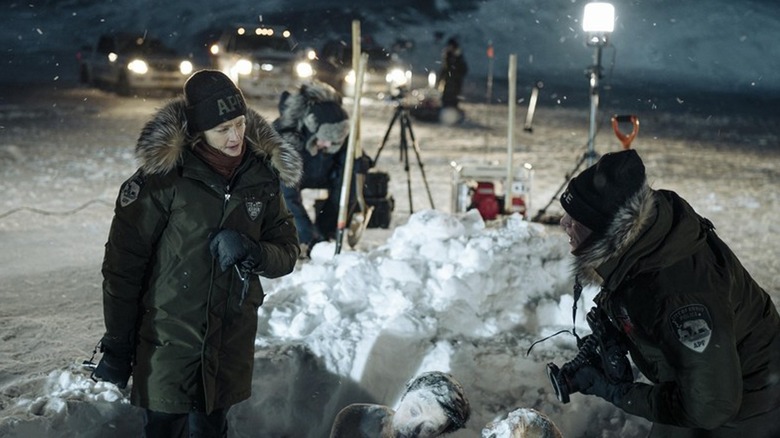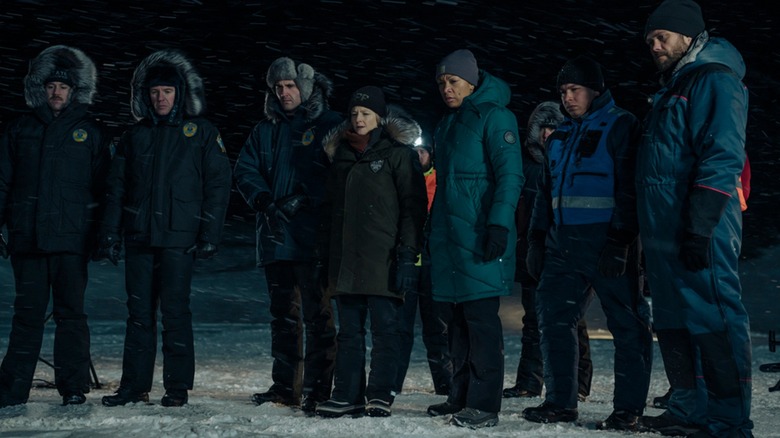True Detective: Night Country Used A Gruesome Pinterest Board For Corpsicle Inspiration
Spoilers for "True Detective: Night Country" follow.
The dark, sleepy mining town of Ennis, Alaska, which is where the events of "True Detective: Night Country" are set, conceals many dark secrets beneath the ice. When a group of researchers go missing from their base, Liz Danvers (Jodie Foster) and the rest of the police force have enough reasons to suspect foul play, but nothing prepares them for what they find. The researchers are found frozen together with no clothes on, their limbs tangled and protruding in various directions, with expressions of pure terror stamped on their icy faces. It is a rather ugly thing to look at, and Danvers immediately describes it as a corpsicle, which is perhaps the most inventive way of referring to this horrifying spectacle.
Writer-director Issa López chooses to linger on these bodies, zooming in on specific body parts that could possibly serve as a clue for solving the mystery that confounds everyone. A spiral is etched on a forehead — which is more than a callback to season 1 — and the bodies are thawed under bright, harsh lights in an attempt to uncover more hidden details. As this mass of thawing flesh and ice needed to look a certain way as the series progressed, a lot of attention and planning went into creating this centerpiece, which was a collaboration between production designer Daniel Taylor and Dave and Lou Elsey's prosthetics team.
Taylor and the prosthetics team spoke to Mashable about this painstaking, yet interesting creative process, explaining the challenges faced during the same, and the visual inspirations that helped define the final piece of art. Here's what they had to say about a Pinterest board provided by López that references 1998's "Ringu," which directly informed the design of the corpsicle in question.
Disorienting artworks inspired Night Country's corpsicle
Dave Elsey explained that the corpsicle is quite literally "a moment frozen in time," which prompted the team to look at artwork that captured similar aesthetics and sentiments. The concept work research included Christy Lee Rogers' photography, featuring Baroque-style underwater photos of dancers who look like they are stuck in time. López also furnished the team with a Pinterest board that referenced the unforgettably disturbing closet scene in "Ringu." Taylor said:
"Issa's obviously got a Pinterest board with references she really likes. If you've seen the Japanese Ring, there's a moment when we find a body in a cupboard. There's a dislocated jaw, and the eyes are looking off at an angle, and Issa was very moved by that."
Apart from taking inspiration from this kind of visceral body horror, Taylor and the prosthetics team also looked into Belgian sculptor Berlinde de Bruyckere, who uses "layers of fabric and silicone" to create installations of tangled bodies with missing heads or dislocated limbs. Taylor also talked about painters Phil Hale and Francis Bacon, whose works often examine the distortions of the flesh to evoke different emotions:
"Then there's an American painter called Phil Hale. And he'd painted a skull, like a shrunken head where the skin has started to dry and pull away from the mouth, and the mouth has been dislocated and [the] eyes are looking really wide at something horrific. Now, that was a real point of reference for her [López]. And then there's Francis Bacon — he had moments from his work that fit into the corpsicle as well."
These influences culminated in a truly impressive art piece that serves as crucial evidence of a seemingly inexplicable crime in a show packed with horrors of an unknowable nature.

